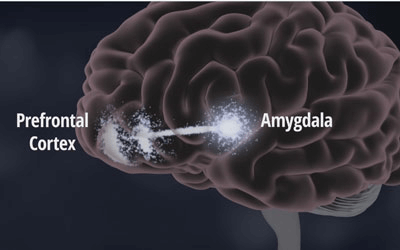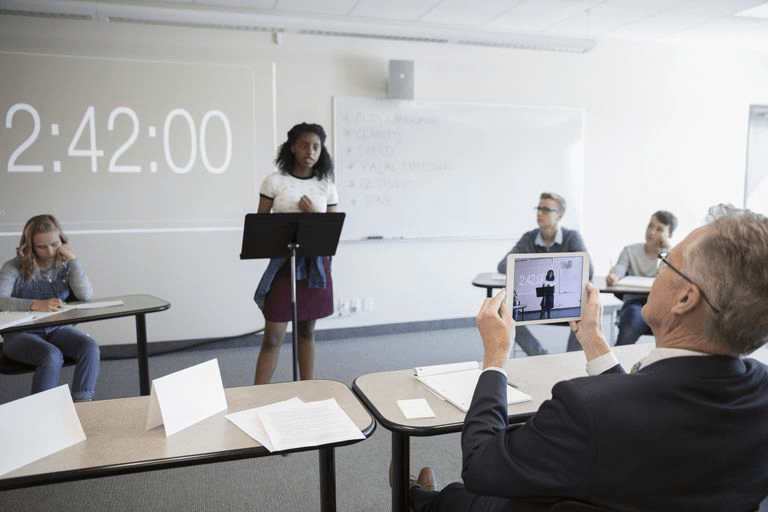How Worrying Works
According to childhood anxiety expert Lynn Lyons, LICSW, it’s important that we as parents understand what happens when we worry — a process she refers to as “The Worry Cycle” — before we learn what to do when worry shows up (aka, How to Help our kids).
So.
Here we are. Let’s mark that off our list.
Preface — Some Brain Stuff
Before going into The Worry Cycle, here’s an overview of the two parts of the brain involved in worry and decision-making:

Amygdala — Lyons (and several of my old MFT grad school professors) refer to this tiny, almond-shaped part of the brain as our “old, primitive brain.” This is the part of the brain that was around in cavemen time. It’s the amygdala that fires every time we’re scared of something (or feel stressed or anxious); it believes the things we worry about are always super dangerous. Like, life-threatening dangerous.
Evolutionarily, this was a good thing — it helped keep us safe from predators. But this defense mechanism hasn’t adapted to modern life. Nowadays when we feel stressed, our lives probably aren’t in mortal danger (i.e. there’s likely not a bear chasing us). Rather, we may be experiencing a stressful situation (speaking in front of the class), recalling a painful memory (totally bombing when we spoke in front of the class), or anticipating a future fear (OMG — I have to speak in front of the class next week!).


Prefrontal Cortex — This is the part of the brain located at the head of the frontal lobe. Lyons refers to this area as the “fancy new brain.” It’s responsible for functions such as planning (long- and short-term), decision-making, goal-setting, problem-solving, and self-control. The prefrontal cortex is not fully developed in children — in fact, it isn’t fully developed until around age 25 (part of the reason their tantrums are so big, and teenagers display such risky behavior).
The Worry Cycle
Understanding The Worry Cycle is crucial because it explains what is actually happening — physically and emotionally — when our kids worry. It tells us how we can help them (and teach them) to interrupt the process. (Note: although we are discussing children, The Worry Cycle — and tips for helping to interrupt it — apply to everyone.)
Interestingly, treatment for anxiety among children is essentially the same whether it’s considered clinically pathological or not. So even if your child (or you!) doesn’t suffer from diagnosed/clinical anxiety, you can still use these techniques to help manage everyday sources of anxiety in your family’s life.
According to Lyons, anxiety stems from a lack of two things:
- 1. Certainty: “I want to know what’s going to happen next… and I want to control it,”
and…
- 2. Comfort: “I want to feel safe and comfortable… or else I want out!”
But guess what? The very nature of life is that it’s uncertain and unpredictable. Ack!

OK, friends, cue The Worry Cycle.
According to Lyons, here’s how it works:
- We have a “Trigger Event” — this could be anything… a big, scary traumatizing episode; being startled by a loud, barking dog; being separated from a caregiver to go to daycare or school; witnessing a friend fall from the jungle gym at the park. Pick your poison.
- That Trigger Event creates “Worried Thoughts” — we worry, and worry, and worry about whatever the thing is… and the more we worry about it, the more dangerous our amygdala perceives it to be. So our worry response to the trigger event — whatever it is — gets heightened EACH TIME we encounter it.
- Worried Thoughts Create Physical Responses and MORE Worried Thoughts — obviously, our brains have evolved, and humans are exceptionally intelligent. Yet, the amygdala still can’t decipher between a THOUGHT and a REAL EXPERIENCE. So when you have worried thoughts — even if what you’re worried about isn’t currently happening or present — your brain thinks you’re actually in danger. Now.
So then what happens? Your body starts to react.
You may experience a racing heart, upset tummy, headache, blurred vision, diarrhea, clammy hands, and more. This is because you are in “fight or flight” mode. In primitive times, when the amygdala was activated (by the bear chasing us, etc.), our bodies needed to prepare to RUN or FIGHT!
This response was, of course, super helpful when we had to actually escape a dangerous situation, but when we have worried thoughts? Not so much. In fact… when these physical responses begin, they end up causing MORE anxious thoughts (about our initial anxiety trigger AND about how “out of control” our body is feeling).
And the more anxious we feel, the more our amygdala fires, and the more physical responses we experience… and it goes on and on.
You get the idea — it’s a vicious cycle. Sheesh.
BUT.
We can help you and your kids work to interrupt it — stick with us for part 4 of the Anxiety Series, on “How to Help.”
To read more about The Worry Cycle and how to interrupt it, check out Lyons’s book Anxious Kids, Anxious Parents: 7 Ways to Stop the Worry Cycle and Raise Courageous and Independent Children.